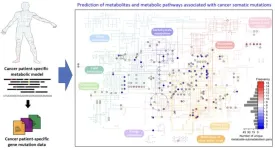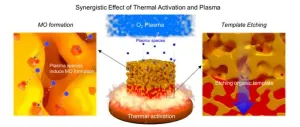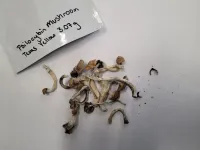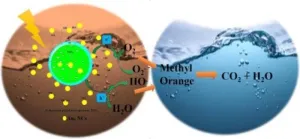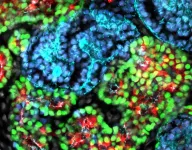(Press-News.org) Cancer is characterized by abnormal metabolic processes different from those of normal cells. Therefore, cancer metabolism has been extensively studied to develop effective diagnosis and treatment strategies. Notable achievements of cancer metabolism studies include the discovery of oncometabolites* and the approval of anticancer drugs by the U.S. Food and Drug Administration (FDA) that target enzymes associated with oncometabolites. Approved anticancer drugs such as ‘Tibsovo (active ingredient: ivosidenib)’ and ‘Idhifa (active ingredient: enasidenib)’ are both used for the treatment of acute myeloid leukemia. Despite such achievements, studying cancer metabolism, especially oncometabolites, remains challenging due to time-consuming and expensive methodologies such as metabolomics. Thus, the number of confirmed oncometabolites is very small although a relatively large number of cancer-associated gene mutations have been well studied.
*Oncometabolite: A metabolite that shows pro-oncogenic function when abnormally accumulated in cancer cells. An oncometabolite is often generated as a result of gene mutations, and this accumulation promotes the growth and survival of cancer cells. Representative oncometabolites include 2-hydroxyglutarate, succinate, and fumarate.
On March 18th, a KAIST research team led by Professor Hyun Uk Kim from the Department of Chemical and Biomolecular Engineering developed a computational workflow that systematically predicts metabolites and metabolic pathways associated with somatic mutations in cancer through collaboration with research teams under Prof Youngil Koh, Prof. Hongseok Yun, and Prof. Chang Wook Jeong from Seoul National University Hospital.
The research teams have successfully reconstructed patient-specific genome-scale metabolic models (GEMs)* for 1,043 cancer patients across 24 cancer types by integrating publicly available cancer patients’ transcriptome data (i.e., from international cancer genome consortiums such as PCAWG and TCGA) into a generic human GEM. The resulting patient-specific GEMs make it possible to predict each patient’s metabolic phenotypes.
*Genome-scale metabolic model (GEM): A computational model that mathematically describes all of the biochemical reactions that take place inside a cell. It allows for the prediction of the cell’s metabolic phenotypes under various genetic and/or environmental conditions.
< Figure 1. Schematic diagram of a computational methodology for predicting metabolites and metabolic pathways associated with cancer somatic mutations. of a computational methodology for predicting metabolites and metabolic pathways associated with cancer somatic mutations. >
The team developed a four-step computational workflow using the patient-specific GEMs from 1,043 cancer patients and somatic mutation data obtained from the corresponding cancer patients. This workflow begins with the calculation of the flux-sum value of each metabolite by simulating the patient-specific GEMs. The flux-sum value quantifies the intracellular importance of a metabolite. Next, the workflow identifies metabolites that appear to be significantly associated with specific gene mutations through a statistical analysis of the predicted flux-sum data and the mutation data. Finally, the workflow selects altered metabolic pathways that significantly contribute to the biosynthesis of the predicted oncometabolite candidates, ultimately generating metabolite-gene-pathway sets as an output.
The two co-first authors, Dr. GaRyoung Lee (currently a postdoctoral fellow at the Dana-Farber Cancer Institute and Harvard Medical School) and Dr. Sang Mi Lee (currently a postdoctoral fellow at Harvard Medical School) said, “The computational workflow developed can systematically predict how genetic mutations affect cellular metabolism through metabolic pathways. Importantly, it can easily be applied to different types of cancer based on the mutation and transcriptome data of cancer patient cohorts.”
Prof. Kim said, “The computational workflow and its resulting prediction outcomes will serve as the groundwork for identifying novel oncometabolites and for facilitating the development of various treatment and diagnosis strategies”.
This study, which was supported by the National Research Foundation of Korea, has been published online in Genome Biology, a representative journal in the field of biotechnology and genetics, under the title "Prediction of metabolites associated with somatic mutations in cancers by using genome‑scale metabolic models and mutation data".
END
A KAIST-Seoul National University Hospital research team develops a computational workflow that predicts metabolites and metabolic pathways associated with somatic mutations in cancers
2024-03-19
ELSE PRESS RELEASES FROM THIS DATE:
Bendable energy storage materials by cool science
2024-03-19
Imaging being able to wear your smartphone on your wrist, not as a watch, but literally as a flexible band that surrounds around your arm. How about clothes that charge your gadgets just by wearing them? Recently, a collaborative team led by Professor Jin Kon Kim and Dr. Keon-Woo Kim of Pohang University of Science and Technology (POSTECH), Professor Taesung Kim and M.S./Ph.D. student Hyunho Seok of Sungkyunkwan University (SKKU), and Professor Hong Chul Moon of University of Seoul (UOS) has brought a step closer to making this realty. This research work was published in Advanced Materials.
Mesoporous ...
Inorganic nitrate can help protect patients against kidney damage caused during coronary angiographic procedures
2024-03-19
A five-day course of once-daily inorganic nitrate reduces the risk of a serious complication following a coronary angiogram, in which the dye used causes damage to the kidneys. The clinical trial, led by Queen Mary University of London and funded by Heart Research UK, also showed that the five-day course improves renal outcomes at three months and major adverse cardiac events (MACE) at one year compared to placebo.
Contrast-induced nephropathy (CIN), also known as contrast associated acute kidney injury (CA-AKI), is an uncommon but serious complication following ...
Active social lives help dementia patients, caregivers thrive
2024-03-19
EMBARGOED FOR RELEASE
6 p.m. PT / 9 p.m. ET, March 18, 2024
To coincide with publication in The Gerontologist
Media Contact: Suzanne Leigh (415) 680-5133
Suzanne.Leigh@UCSF.edu
Subscribe to UCSF News
People with dementia and those who care for them should be screened for loneliness, so providers can find ways to keep them socially connected, according to experts at UC San Francisco and Harvard, who made the recommendations after finding that both groups experienced declines in social well-being as the disease progressed.
The patients, whose ...
New technique measures psilocybin potency of mushrooms
2024-03-19
Since the 1970s, the federal government has listed the active ingredients in mushrooms—psilocybin and psilocin—as illegal and having no accepted medical use.
However, in recent years, medical professionals have found that these substances are safe and effective for treating stubborn conditions such as treatment-resistant depression and post-traumatic stress disorder. Some jurisdictions now allow for the medical use of mushrooms, while others are considering permitting or at least decriminalizing their recreational use.
Clinicians now find themselves needing to carefully ...
UC Irvine-led research team discovers role of key enzymes that drive cancer mutations
2024-03-19
Irvine, Calif., March 18, 2024 — A research team led by the University of California, Irvine has discovered the key role that the APOBEC3A and APOBEC3B enzymes play in driving cancer mutations by modifying the DNA in tumor genomes, offering potential new targets for intervention strategies.
The study, published today online in the journal Nature Communications, describes how the researchers identified the process by which APOBEC3A and APOBEC3B detect specific DNA structures, resulting in mutations at distinct positions within the tumor genome.
“It’s critical to understand how cancer cells accumulate mutations leading to ...
All creatures great and small: Sequencing the blue whale and Etruscan shrew genomes
2024-03-18
The blue whale genome was published in the journal Molecular Biology and Evolution, and the Etruscan shrew genome was published in the journal Scientific Data.
Research models using animal cell cultures can help navigate big biological questions, but these tools are only useful when following the right map.
“The genome is a blueprint of an organism,” says Yury Bukhman, first author of the published research and a computational biologist in the Ron Stewart Computational Group at the Morgridge Institute, an independent research organization that works in affiliation with the University of Wisconsin–Madison in emerging fields ...
Sustainable solution for wastewater polluted by dyes used in many industries
2024-03-18
Water pollution from dyes used in textile, food, cosmetic and other manufacturing is a major ecological concern with industry and scientists seeking biocompatible and more sustainable alternatives to protect the environment.
A new study led by Flinders University has discovered a novel way to degrade and potentially remove toxic organic chemicals including azo dyes from wastewater, using a chemical photocatalysis process powered by ultraviolet light.
Professor Gunther Andersson, from the Flinders Institute for NanoScale Science and Technology, says the process involves creating metallic ‘clusters’ of just nine gold (Au) atoms chemically ‘anchored’ ...
Food companies’ sponsorship of children’s sports encourages children to buy their products, Canadian research suggests
2024-03-18
*This is an early press release from the European Congress on Obesity (ECO 2024) Venice 12-15 May. Please credit the Congress if using this material*
Food companies’ sponsorship of children’s sports may encourage children to buy their products, new research to be presented at the European Congress on Obesity (ECO 2024) (Venice 12-15 May), has found.
The Canadian research also found that many children view food companies that sponsor or give money to children’s sports as being “generous” ...
USC receives $3.95 million CIRM grant for organoid resource center
2024-03-18
To democratize access to lab-grown organ-like structures known as organoids and other advanced stem cell and transcriptomic technologies, USC will launch the CIRM ASCEND Center, dedicated to “Advancing Stem Cell Education and Novel Discoveries.” Funded by a $3.95 million grant from the California Institute for Regenerative Medicine (CIRM), the voter-created state agency charged with distributing public funding to support stem cell research and education, ASCEND joins a network of shared resources laboratories ...
New research finds boreal arctic wetlands are producing more methane over time
2024-03-18
MADISON –– Scientists have been measuring global methane emissions for decades, but the boreal arctic —with a wide range of biomes including wetlands that extend across the northern parts of North America, Europe and Asia — is a key region where accurately estimating highly potent greenhouse gas emissions has been challenging.
Wetlands are great at storing carbon, but as global temperatures increase, they are warming up. That causes the carbon they store to be released into the atmosphere in the form of methane, which contributes to more global warming.
Now, researchers — including the University ...
